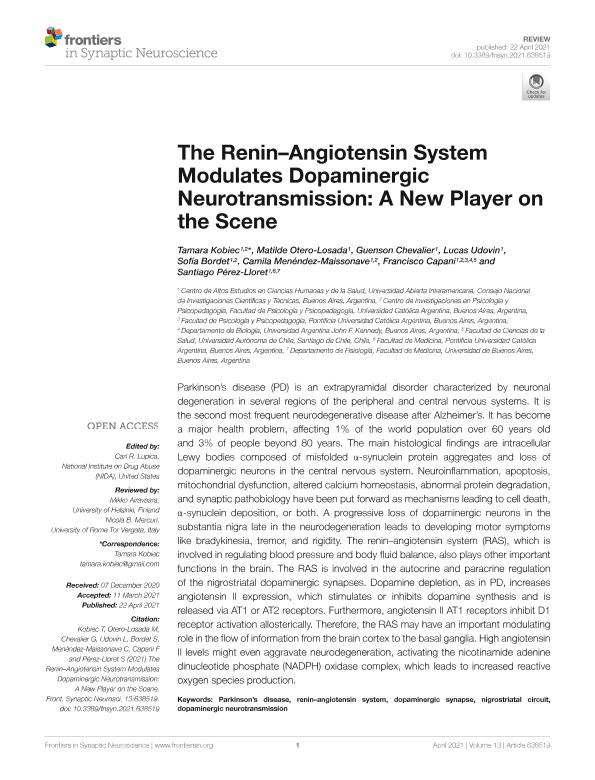Artículo
The Renin–Angiotensin System Modulates Dopaminergic Neurotransmission: A New Player on the Scene
Kobiec, Tamara ; Otero losada, Matilde Estela
; Otero losada, Matilde Estela ; Chevalier, Guenson
; Chevalier, Guenson ; Udovin, Lucas
; Udovin, Lucas ; Bordet, Sofía
; Bordet, Sofía ; Menéndez Maissonave, Camila Belen; Capani, Francisco
; Menéndez Maissonave, Camila Belen; Capani, Francisco ; Perez Lloret, Santiago
; Perez Lloret, Santiago
 ; Otero losada, Matilde Estela
; Otero losada, Matilde Estela ; Chevalier, Guenson
; Chevalier, Guenson ; Udovin, Lucas
; Udovin, Lucas ; Bordet, Sofía
; Bordet, Sofía ; Menéndez Maissonave, Camila Belen; Capani, Francisco
; Menéndez Maissonave, Camila Belen; Capani, Francisco ; Perez Lloret, Santiago
; Perez Lloret, Santiago
Fecha de publicación:
06/2021
Editorial:
Frontiers Media
Revista:
Frontiers in Synaptic neuroscience
ISSN:
1663-3563
Idioma:
Inglés
Tipo de recurso:
Artículo publicado
Clasificación temática:
Resumen
Parkinson’s disease (PD) is an extrapyramidal disorder characterized by neuronal degeneration in several regions of the peripheral and central nervous systems. It is the second most frequent neurodegenerative disease after Alzheimer’s. It has become a major health problem, affecting 1% of the world population over 60 years old and 3% of people beyond 80 years. The main histological findings are intracellular Lewy bodies composed of misfolded α-synuclein protein aggregates and loss of dopaminergic neurons in the central nervous system. Neuroinflammation, apoptosis, mitochondrial dysfunction, altered calcium homeostasis, abnormal protein degradation, and synaptic pathobiology have been put forward as mechanisms leading to cell death, α-synuclein deposition, or both. A progressive loss of dopaminergic neurons in the substantia nigra late in the neurodegeneration leads to developing motor symptoms like bradykinesia, tremor, and rigidity. The renin–angiotensin system (RAS), which is involved in regulating blood pressure and body fluid balance, also plays other important functions in the brain. The RAS is involved in the autocrine and paracrine regulation of the nigrostriatal dopaminergic synapses. Dopamine depletion, as in PD, increases angiotensin II expression, which stimulates or inhibits dopamine synthesis and is released via AT1 or AT2 receptors. Furthermore, angiotensin II AT1 receptors inhibit D1 receptor activation allosterically. Therefore, the RAS may have an important modulating role in the flow of information from the brain cortex to the basal ganglia. High angiotensin II levels might even aggravate neurodegeneration, activating the nicotinamide adenine dinucleotide phosphate (NADPH) oxidase complex, which leads to increased reactive oxygen species production.
Archivos asociados
Licencia
Identificadores
Colecciones
Articulos(SEDE CENTRAL)
Articulos de SEDE CENTRAL
Articulos de SEDE CENTRAL
Citación
Kobiec, Tamara; Otero losada, Matilde Estela; Chevalier, Guenson; Udovin, Lucas; Bordet, Sofía; et al.; The Renin–Angiotensin System Modulates Dopaminergic Neurotransmission: A New Player on the Scene; Frontiers Media; Frontiers in Synaptic neuroscience; 13; 638519; 6-2021; 1-10
Compartir
Altmétricas



